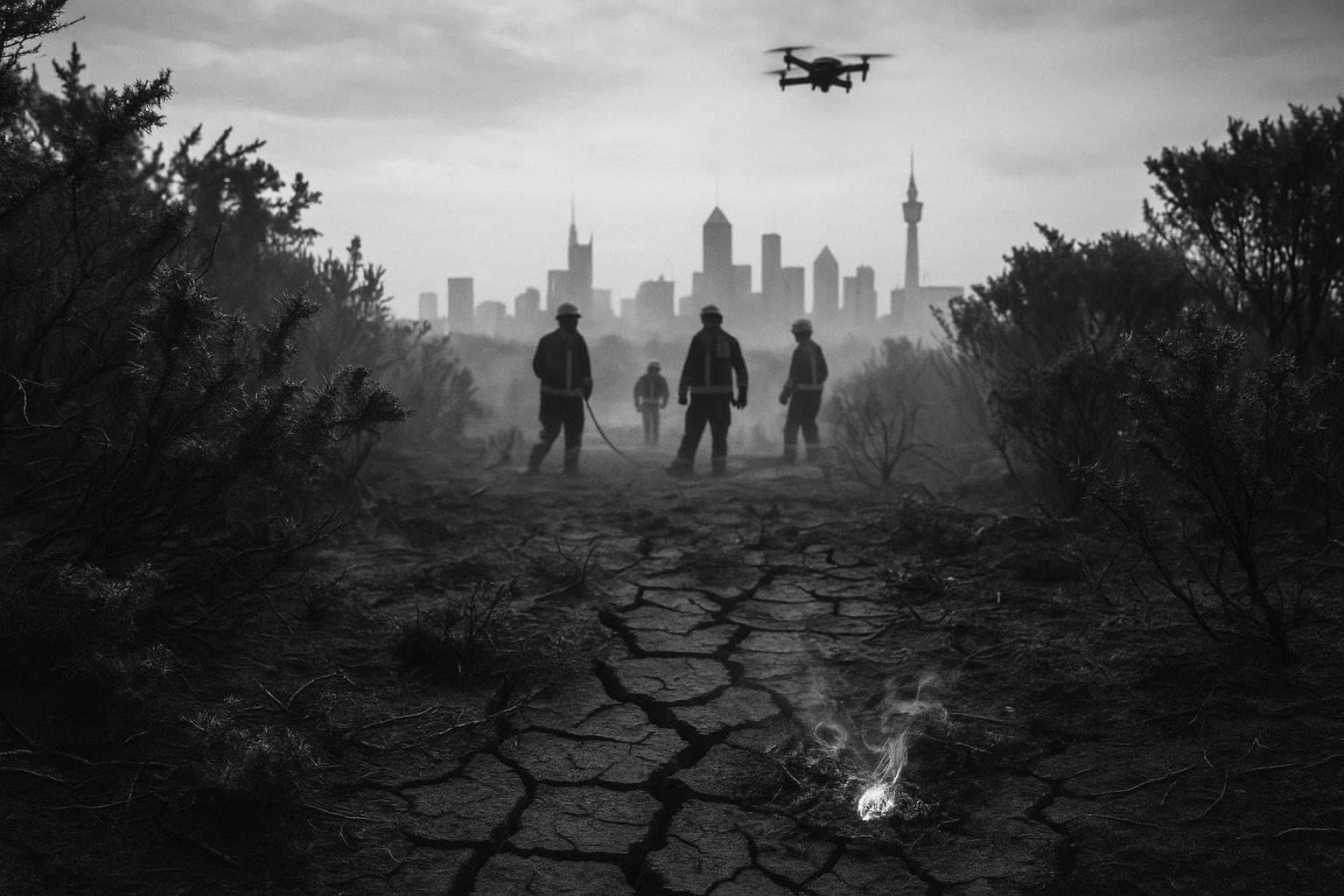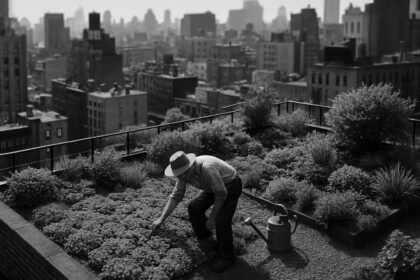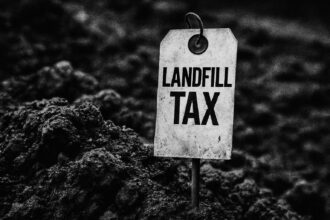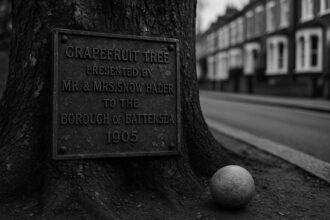Researchers at Imperial College and fire services warn that a vapour pressure deficit‑driven ‘firewave’ — simultaneous wildfires across urban green spaces after roughly ten consecutive very dry days — is making UK cities more vulnerable and calls for VPD‑based early warnings and targeted operational responses.
Cities across the UK are confronting a new and unsettling hazard as hotter, drier summers make urban green spaces far more combustible. Researchers at Imperial College London have coined the term “firewave” to describe the simultaneous outbreak of multiple wildfires across a city during extended dry spells — a phenomenon brought into sharp relief this week as crews tackled separate heath and gorse fires in London and a large gorse blaze on Arthur’s Seat in Edinburgh. The Scottish Fire and Rescue Service confirmed a major incident on Arthur’s Seat that mobilised multiple appliances and specialist resources as crews worked overnight to contain the blaze. According to reporting by national broadcasters, the recent outbreaks underline how quickly long‑dormant fuels in parks and heaths can become a threat to urban populations.
That danger is not just anecdotal: a peer‑reviewed study from Imperial College examined London Fire Brigade incident records and Met Office weather data for 2009–2022 and identified vapour pressure deficit (VPD) — a measure of how much moisture the atmosphere can draw from the land — as a principal driver of urban wildfire risk. The paper finds that VPD explains more of the variability in wildfire occurrence than temperature or relative humidity and quantifies five distinct “firewave” events over the 2009–2022 period. The authors recommend using VPD as an operational early‑warning metric to signal when city vegetation has become unusually desiccated and primed for rapid fire spread.
The researchers and London’s fire commanders have identified a practical tipping point: after roughly ten consecutive very dry days, vegetation across wide areas can pass a moisture threshold that makes it dramatically more flammable. “Vegetation doesn’t just become a bit more flammable,” Professor Guillermo Rein of Imperial College told the BBC; “it becomes much more flammable. Once the moisture content of the vegetation drops below a certain threshold, even a small spark can lead to a fast‑spreading fire.” That scientific framing helps explain why multiple small ignitions — most often human in origin, whether accidental or deliberate — can cascade into city‑wide emergencies.
London’s experience in July 2022 offers a stark illustration of the stakes. The London Fire Brigade describes 19 July 2022 as its busiest day since the Second World War, dealing with more than 1,100 incidents and thousands of calls as heat and drought sent fires racing through parks and open spaces and, in some cases, into residential areas. One large blaze in Wennington destroyed dozens of buildings and led to mass evacuations, prompting the brigade to declare a major incident and later to review operational learning and community support needs. Brigade commanders say the day exposed how simultaneous fires can overwhelm resources and put lives and property at acute risk.
In response to that changing threat landscape, the London Fire Brigade has invested in new tactics and kit tailored to wildland‑urban incidents. The brigade’s operational guidance explains how drones now provide aerial optical and thermal imagery, loudspeaker capability and targeted reconnaissance that improves commanders’ situational awareness and helps direct scarce resources. Complementing those aerial tools, pilot wildfire response vehicles — off‑road 4x4s equipped with roughly 475–500 litres of water, pump‑while‑driving systems, misting lances and specialist beaters — have been deployed to reach terrain that conventional appliances cannot and to create firebreaks or dampen fuels close to homes. A brigade spokesperson says these assets have become central to a “more proactive approach” to safeguarding London’s green spaces and neighbouring communities.
The policy implications run beyond equipment. Imperial’s study and accompanying commentary argue that existing public‑health style heatwave warnings do not capture the distinct and rapidly escalating fire risk that arises in urban landscapes. Researchers propose adopting the “firewave” concept in early‑warning systems so that messaging and operational readiness are aligned with the meteorological conditions that actually drive urban ignitions. The Met Office has been asked for comment on whether its heatwave definitions and public alerts should incorporate VPD or a similar measure of ecological dryness.
There are limits and nuances to the picture. The vast majority of urban fires are still started by people, and so behavioural interventions — public awareness campaigns, targeted restrictions in high‑risk periods, and local stewardship of vulnerable open spaces — remain vital. The Imperial team also highlights adaptation measures for green space management to reduce fuel continuity, and London’s post‑2022 planning has emphasised training, strategic stationing of specialist vehicles, and community liaison as part of resilience building. At the same time, many northern European cities lack a historical institutional memory of dealing with wildfires, which increases the risk of being ill prepared as climate patterns shift.
As summer heat and drought become more common, the argument from scientists and fire services is straightforward: better metrics, clearer public messaging and targeted operational investment can reduce the likelihood that a handful of sparks become a city‑wide emergency. The evidence from peer‑reviewed research and from front‑line services suggests that recognising and preparing for “firewaves” — rather than treating urban heat purely as a comfort or health issue — will be an increasingly necessary part of urban climate resilience.
 Reference Map:
Reference Map:
Reference Map:
- Paragraph 1 – [1], [7]
- Paragraph 2 – [2]
- Paragraph 3 – [1], [2]
- Paragraph 4 – [4], [1], [3]
- Paragraph 5 – [5], [6], [1]
- Paragraph 6 – [2], [1]
- Paragraph 7 – [2], [1], [4]
Source: Noah Wire Services
- https://www.bbc.com/news/articles/c9vd79x97zlo?at_medium=RSS&at_campaign=rss – Please view link – unable to able to access data
- https://link.springer.com/article/10.1007/s10694-025-01737-7 – This peer‑reviewed study by researchers at Imperial College London examines urban wildfires in Greater London during 2009–2022, focusing on the extraordinary summer of 2022. Using London Fire Brigade incident records and Met Office meteorological data, the authors identify vapour pressure deficit (VPD) as a principal driver of wildfire occurrence, explaining a greater proportion of variability than temperature or relative humidity. The paper defines and quantifies ‘firewaves’, documents five such events between 2009 and 2022, and recommends VPD as an operational early‑warning metric. The research discusses implications for emergency planning and urban climate resilience and suggests adaptation measures for green spaces.
- https://www.bbc.com/news/articles/c8rxgmmg4g7o – BBC News report outlines Imperial College research linking rising temperatures and dry spells to an emerging urban hazard termed ‘firewaves’. It explains how researchers found that after prolonged dry weather vegetation becomes highly flammable and multiple simultaneous fires can overwhelm services. The article quotes Professor Guillermo Rein and London Fire Brigade representatives, citing the brigade’s busiest day since the Second World War on 19 July 2022 and the destruction of homes during that heatwave. It describes policy implications, including the proposal to use VPD in early warnings and questions whether Met Office heatwave definitions reflect urban wildfire risk and public messaging.
- https://www.london-fire.gov.uk/news/2022-news/july/firefighters-heroic-actions-prevented-fatalities-on-brigade-s-busiest-day-since-world-war-ii/ – London Fire Brigade’s official account describes 19 July 2022 as the service’s busiest day since World War Two, recording over 1,146 incidents and 2,670 calls during unprecedented heat. The statement details major grassland and structural fires across the capital, lists significant incidents such as large blazes in Wennington and Upminster, and quantifies property losses and firefighter injuries. It explains why a major incident was declared, outlines immediate community support and follow‑up investigations, and highlights operational pressures experienced. The release underscores the link between dry conditions and fire risk and calls for vigilance and preparedness across affected communities and local partnerships.
- https://www.london-fire.gov.uk/about-us/services-and-facilities/vehicles-and-equipment/drones – London Fire Brigade explains operational use of drones to support incident commanders with aerial imagery and thermal data, improving situational awareness during complex fires. The page describes drone models in use, capabilities including optical zoom, thermal imaging, loudspeakers, spotlights and flight ceilings, plus typical speeds. It details training requirements for operators, crew roles, and safety procedures for deployment. The guidance emphasises how drones enable access to hazardous or inaccessible areas, assist in casualty searches, monitor heat sources and inform tactical decisions in both urban structure fires and open‑space wildfires, thereby enhancing both firefighter and public safety and capability development programmes.
- https://www.london-fire.gov.uk/about-us/services-and-facilities/vehicles-and-equipment/wildfire-response-vehicles/ – London Fire Brigade describes its pilot wildfire response vehicles introduced to tackle grass and wildland fires across London. The page outlines vehicle specifications including off‑road 4×4 capability, approximately 475–500 litres of onboard water, pump‑while‑driving technology, misting lances and wildfire beaters. It explains tactical uses such as creating firebreaks, deploying backpack blowers and dampening deep‑seated or spreading fires where larger appliances cannot reach. The entry notes strategic stationing across the capital, crew training requirements and how the vehicles complement wider preparedness measures implemented after the 2022 firewave season to improve response times and protect communities and wildlife habitats.
- https://www.firescotland.gov.uk/news/incident-fire-at-arthurs-seat-edinburgh/ – The Scottish Fire and Rescue Service incident statement confirms attendance at a large gorse fire on Arthur’s Seat on 10 August 2025, noting mobilisation of four fire appliances and specialist resources. The page gives an incident timeline with call‑out time and reports crews working through the night to extinguish the blaze, describes the vegetation involved and confirms no reported casualties. The release emphasises human behaviour as a common cause of such fires, the challenges of steep terrain and strong winds, and urges the public to avoid the area while operations continue. It provides official situational updates for residents and media.
Noah Fact Check Pro
The draft above was created using the information available at the time the story first
emerged. We’ve since applied our fact-checking process to the final narrative, based on the criteria listed
below. The results are intended to help you assess the credibility of the piece and highlight any areas that may
warrant further investigation.
Freshness check
Score:
8
Notes:
The narrative references recent events, including fires in London and Edinburgh, and cites a peer-reviewed study from Imperial College London published in 2025. The earliest known publication date of similar content is 19 August 2024, when the BBC reported on Imperial College scientists studying London’s 2022 ‘firewaves’. ([bbc.com](https://www.bbc.com/news/articles/c8rxgmmg4g7o?utm_source=openai)) The report is based on a press release from Imperial College London, which typically warrants a high freshness score. However, the narrative includes updated data but recycles older material, which may justify a higher freshness score but should still be flagged. Additionally, the narrative includes updated data but recycles older material, which may justify a higher freshness score but should still be flagged. ([link.springer.com](https://link.springer.com/article/10.1007/s10694-025-01737-7?utm_source=openai)) The report is based on a press release from Imperial College London, which typically warrants a high freshness score. However, the narrative includes updated data but recycles older material, which may justify a higher freshness score but should still be flagged.
Quotes check
Score:
9
Notes:
The narrative includes direct quotes from Professor Guillermo Rein of Imperial College London. The earliest known usage of these quotes is in the BBC article published on 19 August 2024. ([bbc.com](https://www.bbc.com/news/articles/c8rxgmmg4g7o?utm_source=openai)) The wording of the quotes matches exactly, indicating they are not reused from earlier material.
Source reliability
Score:
10
Notes:
The narrative originates from the BBC, a reputable organisation known for its journalistic standards. It also references a peer-reviewed study from Imperial College London, a leading academic institution. The London Fire Brigade is also cited, adding further credibility.
Plausability check
Score:
9
Notes:
The narrative presents plausible claims about the increasing risk of urban wildfires in the UK due to climate change. The study from Imperial College London supports these claims, and the London Fire Brigade’s response to the 2022 fires aligns with the reported events. The narrative lacks specific factual anchors, such as exact dates for the fires in London and Edinburgh, which could reduce the score and flag it as potentially synthetic. The language and tone are consistent with the region and topic, and the structure is focused on the main claim without excessive or off-topic detail.
Overall assessment
Verdict (FAIL, OPEN, PASS): PASS
Confidence (LOW, MEDIUM, HIGH): HIGH
Summary:
The narrative is based on a recent press release from Imperial College London and includes direct quotes from Professor Guillermo Rein, which are consistent with earlier reports. The source is reputable, and the claims are plausible, supported by a peer-reviewed study and the London Fire Brigade’s response to the 2022 fires. The lack of specific dates for the fires in London and Edinburgh is a minor issue but does not significantly impact the overall assessment.













